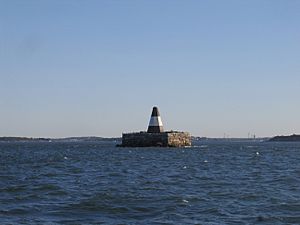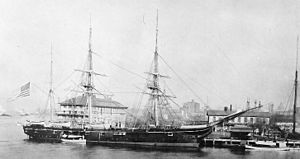Boston Marine Society facts for kids
The Boston Marine Society is a special group in Boston, Massachusetts, that started way back in 1742. Its main goals are to make ocean travel safer and to help its members and their families when they face tough times or accidents. Most members are current or former ship captains. The society gives money to families who need it and also helps make decisions about important things like where to put lighthouses and buoys, and who should guide ships safely into Boston Harbor.
Contents
A Look at Their History
The Boston Marine Society began as a friendly group in 1742 and became an official organization in 1754. Some of its first leaders included William Starkey and Joseph Prince. For its first 100 years, the society held meetings in different places like the Concert Hall and the Bunch-of-Grapes tavern. Later, they had offices on Commercial Street. Since the 1980s, they have been located in the Boston Navy Yard.
A famous sea historian, Samuel Eliot Morison, said that the society's meetings were a place where everyone in Boston interested in sea trade could meet. In 1811, the group had over 100 former ship captains who had retired with enough money. It also included about 50 important merchants and ship owners. The rest were younger sailors who still worked at sea. These active sailors helped make Boston famous around the world.
Keeping the Seas Safe
The society has been in charge of safe ship guidance in Boston Harbor since the 1700s. Since 1791, the society has had the power to choose "Pilot Commissioners." These commissioners then pick the pilots who guide ships in and out of Boston Harbor. The society also published guides, like the 1832 Rules and Regulations for the Pilotage of the Harbor of Boston.
The society helped create the Cape Cod Light in 1797. In 1805, they built the strong granite base for the beacon on Nixes Mate in Boston Harbor. They also did studies that led to the building of Long Island Head Light in 1819.
Building Lighthouses and Beacons
Among their many achievements in sea safety, the society published Directions for Sailing in and out of Plymouth Harbour in 1768. This was connected to the building of Plymouth Light that same year. In 1790, they created maps of the North American coast. They also published Directions for Sailing by Cape-Cod Light-House in 1797.
Other Important Work
Besides making the seas safer, the society has also focused on collecting and giving out money. This money helps members and their families when they are in financial need.
Supporting Members and Families
The society has also hosted many talks. In the 1800s, speakers included John Pickering, who talked about "telegraphic language," and Robert Bennet Forbes.
Learning and Training
In 1893, the society started helping to manage school ships. These ships were the Enterprise (from 1892 to 1909) and its next ship, the Nantucket (from 1909 to 1917, and again from 1921 to 1940). These ships were part of the Massachusetts Nautical Training School, helping to train future sailors.
Preserving Sea History
As a central place for people interested in the sea, the society has looked after many gifts. These include model ships, telescopes, paintings, scrimshaw (art made on whalebone or ivory), and souvenirs from travels. Visitors to the society's current home in Charlestown can see some of these interesting objects on display.
People Who Made a Difference
Many important people have been members of the Boston Marine Society. In the 1700s, members included William Furness and John Foster Williams. Some presidents from that time were Thomas Dennie and Mungo Mackay. In the 1800s, members included J.D. Farrell and F.W. Macondray. When clipper ships were very popular, many were captained or owned by society members like Forbes and Glidden. Some presidents in the 1800s were Jonathan Chapman, Robert Bennett Forbes, and William F. Sturgis. More recently, members and officers have included William A. Baker and Barry Clifford.



